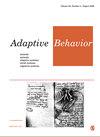走向行为的功能分类:基于结果的分类法
IF 1.3
4区 计算机科学
Q4 COMPUTER SCIENCE, ARTIFICIAL INTELLIGENCE
引用次数: 0
摘要
历史上,行为分类使用两种方法中的一种来完成,要么通过假设的原因(如“本能”、“驱动”和“需求”),要么通过使用族谱对可观察到的行为形式进行分类。本文提供了一种仅基于行为结果的行为分类的替代框架。该框架是从状态空间方法的第一原则中指定的,允许我们讨论可能具有工具价值的中间结果。这种方法可以为考虑目标的层次性质提供更坚实的基础,并允许我们在单一框架内解决“如何”和“为什么”的问题。这种分类法旨在补充而不是取代现有的分类法;按结果对行为进行分类与决策机制或行动实施的问题是正交的。本文指定了九类基本的行为,并为每一类行为提供了精确的定义。然后,我们开发了一种形式语言来描述观察到的活动,行为层次的表示和实现未来目标的可能性集的分析。接下来,我们对这种框架所带来的问题进行了一些批评和讨论。本文章由计算机程序翻译,如有差异,请以英文原文为准。
Towards a functional classification of behaviour: a taxonomy based on outcomes
The classification of behaviour has historically been done using one of the two approaches, either through the hypothetical causes (such as ‘instincts’, ‘drives’ and ‘needs’) or through the cataloguing of the observable form of behaviour using an ethogram. This article offers an alternative framework for classification of behaviour based upon only the behavioural outcomes. The framework is specified from first principles of a state-space approach, allowing us to discuss intermediate outcomes that may have instrumental value. This approach could provide a firmer foundation to consider the hierarchical nature of goals and allows us to address both the ‘how’ and the ‘why’ questions within a single framework. This taxonomy is designed to complement rather than replace existing attempts; the classification of behaviour by outcome is orthogonal to questions of the mechanisms of decision making or of the implementation of actions. This article specifies nine basic classes of behaviour and provides precise definitions for each of these. We then develop a formal language for the description of observed activities, the representation of behavioural hierarchies and for the analysis of possibility sets for achieving future goals. We follow up with some critique and discussion of the problems such a framework poses.
求助全文
通过发布文献求助,成功后即可免费获取论文全文。
去求助
来源期刊

Adaptive Behavior
工程技术-计算机:人工智能
CiteScore
4.30
自引率
18.80%
发文量
34
审稿时长
>12 weeks
期刊介绍:
_Adaptive Behavior_ publishes articles on adaptive behaviour in living organisms and autonomous artificial systems. The official journal of the _International Society of Adaptive Behavior_, _Adaptive Behavior_, addresses topics such as perception and motor control, embodied cognition, learning and evolution, neural mechanisms, artificial intelligence, behavioral sequences, motivation and emotion, characterization of environments, decision making, collective and social behavior, navigation, foraging, communication and signalling.
Print ISSN: 1059-7123
 求助内容:
求助内容: 应助结果提醒方式:
应助结果提醒方式:


